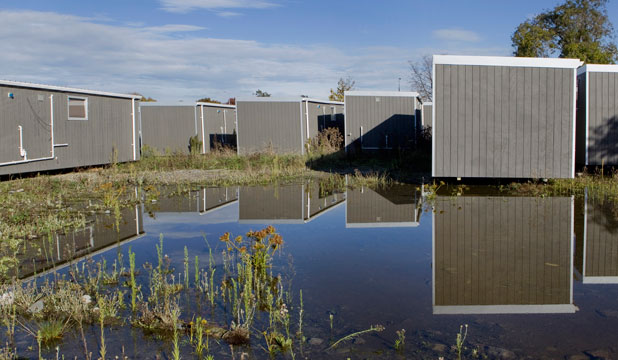One of the main reasons that we should all be very wary of the Government stepping in to “sort out councils” and “provide low-cost housing” is that, judging by their efforts in Canterbury, they have not got a clue about what they are doing. This recent article in The Press didn’t make it into our papers up here, but the picture tells the story all too clearly:

“The weeds grow tall between 37 government-owned transportable housing units as a second winter of sitting idle at a city site approaches. However, the Government hopes to find a private sector partner to put them into service this year, almost 18 months after they were stockpiled at the Christchurch Women’s Hospital site in Durham St. The Department of Building and Housing, now part of the Ministry of Business, Innovation and Employment, commissioned 50 units after the February 2011 quake at a cost of about $2 million. A mixture of single and two-bedroom units, they were part of a plan to set up living quarters in people’s backyards while their homes were repaired or rebuilt. Once the repairs were complete, the units would be relocated to the next property. That idea was canned because the Government decided to use temporary residential villages instead.”
These housing units were completely derided at the time for their complete lack of design intent and desirability, yet the Government went ahead with the deal, commissioning 50 of them, apparently, but it seems that they were only able to get rid of 13 at most. Nobody in their right minds, even a poor homeless Cantabrian, wants to be shacked up in that most awful of badly designed sheds. Our government, never the brightest cookie in the jar to start with, is steaming ahead with decisions that continue to make little sense. Ex woodwork teacher Brownlee advises that “demolitions are speeding up” despite that the quakes were over two years ago, and we should be in the middle of a confidence building rebuilding boom.
Similarly, about 4 months after the big southern quake, the government announced that it had secured a fleet of 350 Campervans for people to use, while they waited for their temporary house. From memory, only a single van was used in the end – and this was at the end of a cold snowy winter, where people had been camping inside their broken homes with their broken toilets, and dying houses. Campervans are indeed a great short-term measure – needed on about Day One or Day Two after a disaster, but let’s face it, by Day Three you have probably found some alternative accommodation. The response from Brownlee and the incompetent crew at CERA was the right response, but a total 6 months too late, and therefore irrelevant.
That’s what makes me wonder why ministers like Nick Smith and Bill English think that they have a chance of doing this work better / faster / cheaper than local Councils. Paratai Drive in Auckland is pretty low-affordability, as is Grafton Road here in Wellington, yet I suspect that they are not the areas that Nick Smith meant. Can anyone show me one instance where a government department has stepped in and done a good job of providing low-cost housing in an area of low affordability?




Maximus – I can’t tell you whether govt depts have or haven’t done the job, good or otherwise, of providing low cost housing, but what is very clear is that this Government is being extraordinarily directive in intervening in what has previously been local government’s role. You only have to look at changes to almost certainly the three most important pieces of legislation affecting local government (the Local Government Act, Resource Management Act, and Land Transport Management Act). There have been a raft of changes made all giving power for Central Government to intervene and direct local government. You also see the discussion this week about Government’s willingness to intervene in Auckland over housing provision. I’ve just read the Government’s own Productivity Commission report which in essence concludes that Central Government doesn’t understand Local Government – however it is happy to intervene, often based on little more than its own philosophical disposition. Fundamentally it appears the current Government thinks Local Government is an extension of itself, another department to be directed.
I wonder whether anyone else has spotted the huge inconsistency of this Government encouraging larger ‘Super Councils’ but at times in the very same piece of legislation, seeking to remove powers from these supersized councils ?
Regards
Andy, I certainly have noticed the appalling disregard for New Zealand and New Zealanders from the current National Government, and the Maori Party should be ashamed of siding with them. The sole ACT prat left, of course has no shame. I think the malaise runs deeper than just Jonkey and his schoolboy chums.
What our country evidently urgently needs is a Constitution. We are apparently one of only two countries in the modern world that don’t have one – the other being Britain. They have the Magna Carta as an important founding bit of legislation – whereas we have the Treaty of Waitangi. Until we have a legally settled basis for all people in Aotearoa, then shonky governments can continue to through their weight around. We got rid of the Upper House in the 50’s and have had no real checks or balances since.
When I saw this picture, I thought of the critique done at the time by the Freerange Press collective.
http://www.projectfreerange.com/whats-going-wrong-in-christchurch/
“The announcement is proof that the Government is successfully doing a miraculous job of delivering housing that is expensive, slow and low quality. There is a well known management triangle for project delivery that states that projects can be quick, cheap and good quality, but can only be two of these. The government is proving innovative in its ability to fail at all three.”
and
“The proposed house designs are just low quality versions of what is built for permanent use in NZ and this doesn’t seem to suit anyone much. The second problem is a cultural and leadership one that sees no potential for innovation. It illustrates not only a complete lack of imagination, but also an ideology that is resistant to using expertise and international precedent.”
Hear hear!
Just coined today on the DimPost blog: Brownleemarama.
If I could discuss something completely different… I came across this yesterday: http://natlib.govt.nz/records/23100743
I didn’t know we were reclaiming vast amounts of land as recently as 1973. But:
1. The “lagoon” looks far too close to St Johns and Odlins. It is about where the open area and the Waka House are now. Also, there is no route from the lagoon to the sea. This makes me think that the area of water in the photo is waiting to be filled in, and the lagoon and the channel were completely dug out later from the newly reclaimed land.
2. The rowing club is next to St Johns. It took me a while to think “that isn’t right!” It must have been moved, but when and how?
3. I think the building in the foreground is gone. I don’t recognise the roof. It must have been just south of City and Sea. So, the land on the sea side of Jervois Quay must have been reclaimed at an earlier date. Were the buildings the whole length of Jervois Quay here? If so, why were they all removed? Or was there only the building in the photo, it was demolished, and Jervois Quay ran along the shore at some stage?
Davidp – we’ve been reclaiming land wildly here in Wellington since the 1850s… but in answer to your questions:
1 – yes, the lagoon is an entirely articial construct, and has been reshaped on many/some occasions. It was constructed to help launch the rowing boats
2 – The Star Rowing club has been moved at least once – perhaps twice? And turned around 90 or 180 degrees too.
3 – there were Wharf Sheds the full length of Jervois Quay, and in the 70s / 80s the ones at the southern end were pulled down. We’re lucky that they kleft sheds 11 and 13, which are the lovely old brick ones – a lot of the other sheds were just corrie iron sheds, probably at the end of their life. The much-derided Queens Wharf events centre building was designed to look like a shed, as it replaced an existing shed, and the developers thought that people would not mind too much that it was slightly larger.
the Star Boating Club has a long and interesting history, available to read at http://www.starboatingclub.com/history
This page goes into considerable detail, but the long and the short of it is:
“The first clubhouse (1867) was near the cenotaph, by Parliament.
Club moved in 1874 and again in 1883 – the present clubhouse was completed in 1887. The new clubhouse was built on skids – and in 1889 further reclamation work forced the club to move again. This time the clubhouse was towed behind a steam engine to where it would stay for a hundred years. In 1989 it was moved to where it stands today by Frank Kitts Lagoon.”
The lagoon was present on the edge of the Quay, so that the boats could be launched – then when the waterfront was straightened up, the lagoon proper was created, and the Star was moved, and rotated 180 to face towards the city, not out to sea.
Next thing someone’ll be getting all sentimental over the Grassy Knoll…
Lest we forget –
http://www.flickr.com/photos/59506011@N05/5817068840/
Born of the dumpings from the lagoon excavation; irritatingly steep for any practical use; a severe blockage to those much lauded view shafts… and then the subject of a campaign to save it.
Thanks for the information, folks. I was a small boy when the 1973 reclamation was going on, so I have some excuse for not knowing it was happening. But I was working in Southpac House (the reflective blue building opposite Frank Kitts Park) in the late 80s shortly before I headed off to Europe and Australia for the best part of twenty years, and I had no idea the rowing club was in a different place then. Partly that is my cluelessness. But probably it also reflects the reduced access to the waterfront in those days.
And I’d forgotten the grassy knoll. I recall encountering that at some stage. I don’t think it was there when I returned to Wellington in 2007. When did it go?
Those canny old fashioned people… Build your structures on skids so you can move them when you get bored with their current location! Some of my family were original settlers to the Waimea (south of Nelson) in 1841 and 1842. The locals wanted to start a school. The provincial authorities had a small building they could use but that was in Nelson. The local men went in to Nelson, moved the building on to skids, and dragged it back to Spring Grove using oxen. Then the teenage daughter of one of the settlers was appointed the first teacher.
davidp – I’m doing some research into an early architect / education board person from earlyish days in the Nelson region – called Stead Ellis – do you have an info on him? He arrived in 1880, so not quite as early as your family (called the P family?) – but I’d be keen to learn more. The bit about moving buildings by oxen is great – they were a very practical, pragmatic lot in those days – is that info in a book anywhere, or just family folklore?
Guy… Sorry, I’ve never heard of Ellis. Most of what I’ve learned about the early settlers in the Waimea comes from Papers Past (Archives site where they’ve digitised and OCRed early newspapers). Also, my great great grandfather William White was a member of the provincial council at one stage. The council Hansard-equivalent is held at Wellington library and I once spent half a day going through them trying to find out if he’d said or done anything famous. He hadn’t.
The Waimea settlers were pretty big on recording things that happened in the settlements. Dances, school prizegivings, and all manner of disputes were reported in the local paper in excruciating detail. My crowd always seemed to be in court over minor matters. Such as assaulting someone in a bar (“if you heard what he said then you’d have punched him too your honour”). Or destroying someone’s home-made dam on the Waimea River (“I admit that I was seen in the vicinity at the time, and I admit that the dam builder and I have been arguing about the dam for months, but I didn’t do it your honour”). Or having your son arrested after he tried to kill you (that was actually part of Geoffrey Palmer’s family… we’re very distant cousins).
Oh, and the Rutherfords were next door neighbours. Ernest was a small boy when they moved in to Nelson city. I wonder if he was always blowing things up, and taking things to bits to see how they worked?
Starkive, the grassy knoll was a preload.
Basically if you stick a big load of dirt on an area it squishes the ground (preloads) under then you can scrape it off after a couple of years then the ground is compacted ready to build on.
If you drive the Rimutaka Hill Road there is a preload on the inside of one of the corners – later on they’ll scrape off the top then run the road straight over it.
Max, is this some sort of record for most wayward thread?
The funny thing is, Waterfront Watch made pretty certain nothing could be built – or be moved – on there. Must be a very sound footing for the strollers.
60 – wayward? Well, yes, now that you’ve taken us to Muldoons Corner in the Rimutakas! And I thought preloading was something that teenagers did before hitting Courtenay Place !
Of course, bringing the topic back to the “houses” pictured at top of his post, I feel I have to give credit to the Government for having some emergency housing sitting there, ready to roll, so to speak. Of course, the other side of me feels that it is more than likely that these units will be quietly trashed, in the future, as they are probably rotting already from neglect. That big puddle of water and weeds won’t be doing anyone any good….
If you insist on bringing your unruly school of fish back to the reef, can I point out that just around the corner from Paratai Drive is a cluster of sturdy 1940s(?) houses built at very affordable price by a former government and tenanted for years by grateful and apparently careful inhabitants at very affordable rents? Trouble is, they had views over Orakei Basin which were ultimately considered to be wasted on the likes of them. Apparently those cats could not look over at the Remuera kings. The state houses were sold off and kickstarted on their ascent to ultimate unaffordability.
What odds that a future government will ever have the courage to turn back the clock and build good quality social housing in places where even a cabinet minister might be happy to live?
The Orakei cats and the Remuera kings? Nice turn of phrase… Well, I’m reasonably sure that the whole Orakei peninsula is a little fraught with issues, not just the State housing area. Aside from Bastion Point, which from memory is just another part of it, isn’t this the area where state houses have been removed so that a greater housing density can be achieved? The implication was that the replacement housing would be for a range of dwellings, not just rich, and not just the poor. I’m all for that in principle, as long as DO actually stick to their principles and don’t just sell it off to the highest bidder.
And – a question – what ever Did actually happen to the land at Bastion Point?